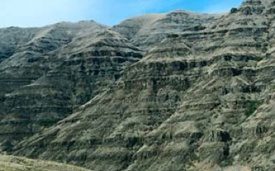Overview
 Geologic carbon capture and storage (CCS) is the process of capturing carbon dioxide (CO2) from the point of release and permanently storing it in deep, underground rock formations. To achieve this, the CO2 is separated from other gases, pressurized to a nearly liquid state, transported to an appropriate storage location, and injected deep underground for permanent isolation from the atmosphere. Geologic CCS approaches are an attractive option for mitigating CO2 emissions due to the widespread presence and storage capacity of suitable geologic CCS settings, including deep saline formations, basalt formations, oil and gas reservoirs, and unmineable coal beds.
Geologic carbon capture and storage (CCS) is the process of capturing carbon dioxide (CO2) from the point of release and permanently storing it in deep, underground rock formations. To achieve this, the CO2 is separated from other gases, pressurized to a nearly liquid state, transported to an appropriate storage location, and injected deep underground for permanent isolation from the atmosphere. Geologic CCS approaches are an attractive option for mitigating CO2 emissions due to the widespread presence and storage capacity of suitable geologic CCS settings, including deep saline formations, basalt formations, oil and gas reservoirs, and unmineable coal beds.
Deep Saline Formations
Deep saline formations are layers of porous rocks, such as sandstones, that are filled with salty water called brine. Overlaying the porous rocks is an impermeable rock layer, such as shale or clay. This dense top rock layer is important for geologic CCS because it functions as a seal to effectively 'trap' the injected CO2 underground. Due to their extensive presence around the world, deep saline formations are estimated to have the largest storage capacity for CO2 injection and storage.
Flood Basalt Formations
 Flood basalts are formed when very large volcanic eruptions create expansive lava flows that cool and solidify into thick basaltic rock formations. These flood basalts are composed of individual flows tens to hundreds of layers thick. The fast-cooling tops of basalt flows are full of cracks and holes, while the slower-cooling interiors form dense, impermeable barriers. Similar to saline formations, the porous rock layers of flood basalts are well suited to store CO2, while the dense overlying rock layers serve as a 'cap rock' and seal the CO2 underground. Laboratory experiments suggest that basalt rocks are unique in that they can rapidly convert injected CO2 into solid carbonate minerals, thereby permanently trapping and storing the CO2.
Flood basalts are formed when very large volcanic eruptions create expansive lava flows that cool and solidify into thick basaltic rock formations. These flood basalts are composed of individual flows tens to hundreds of layers thick. The fast-cooling tops of basalt flows are full of cracks and holes, while the slower-cooling interiors form dense, impermeable barriers. Similar to saline formations, the porous rock layers of flood basalts are well suited to store CO2, while the dense overlying rock layers serve as a 'cap rock' and seal the CO2 underground. Laboratory experiments suggest that basalt rocks are unique in that they can rapidly convert injected CO2 into solid carbonate minerals, thereby permanently trapping and storing the CO2.
Oil and Gas Reservoirs
 CO2 has been injected into underground oil reservoirs for more than 30 years as a method to increase oil production, known as enhanced oil recovery (EOR). When CCS activities involve an enhanced fuel recovery component, such as EOR, the process is referred to as carbon capture, utilization, and storage (CCUS). As CO2is injected into the oil reservoir, it mixes with the oil decreases its viscosity. The lower viscosity level allows the oil to move freely towards production wells and increases overall production. EOR is an attractive option for underground CCS because the costs associated with CCS are offset by the revenue from recovery of additional oil, which may have otherwise remained underground. Any CO2 that is produced with the oil is re-injected back into the reservoir as part of a closed loop system.
CO2 has been injected into underground oil reservoirs for more than 30 years as a method to increase oil production, known as enhanced oil recovery (EOR). When CCS activities involve an enhanced fuel recovery component, such as EOR, the process is referred to as carbon capture, utilization, and storage (CCUS). As CO2is injected into the oil reservoir, it mixes with the oil decreases its viscosity. The lower viscosity level allows the oil to move freely towards production wells and increases overall production. EOR is an attractive option for underground CCS because the costs associated with CCS are offset by the revenue from recovery of additional oil, which may have otherwise remained underground. Any CO2 that is produced with the oil is re-injected back into the reservoir as part of a closed loop system.
Unmineable Coal Seams
Coal seams that are too deep or too thin to be economically viable are referred to as unmineable coal seams. CCS in unmineable coal seams is usually done in conjunction with enhanced coal bed methane recovery (ECBM), implying it is a CCUS strategy. As CO2 is injected into the coal, it adheres to the coal surface, displacing methane-rich gas that was previously adsorbed to the coal and that can now be recovered. Like EOR, ECBM is economically beneficial because the costs of CCS are offset by the capital gained from the methane recovery.
